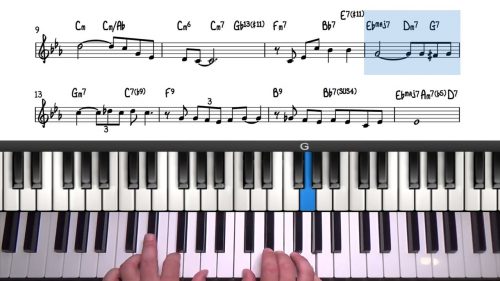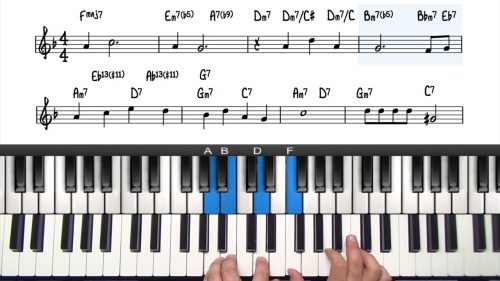Straight No Chaser Tutorial
Welcome to the first blues standard tutorial on the famous tune "Straight No Chaser" by Thelonious Monk.
"Straight no Chaser" is most often played in the key of F, so it’s an F Blues. Its very closely related to the standard jazz blues so if you are familiar with that set of chord changes you will have no problems learning the form and harmony for this tune.
The most interesting thing about "Straight No Chaser" is the displacement of the melody. The main melodic motif if the head is an ascending phrase that’s repeated throughout but placed on different beats of the bar.
We’ll approach it at a medium tempo of about 120 bpm. At this tempo we will play once through the head, and then move straight into some improvisation.
You should be aware that if you were playing at faster tempos, it’s common to play the head twice before moving into the improvised sections. I’m going to play the melody exactly as it’s written but I will be playing with a swing feel.
We are going to incorporate everything we have studied with the blues so far. One recommendation would be think about the dynamics of your solo. For example you don’t want to start of with your best stuff, keep it simple to begin with and remember that a great solo will develop into a climax and gradually wind back down.
Check out the poll in the forum where you can vote on the blues tunes and theory topics that you want to see on the website.
Share and discover your favourite blues records and take part in the transcription exercises to develop your improvisation skills.
Lesson Downloads
-
12 Bar Blues Lesson Supplement File Type: pdf
-
“Straight No Chaser” – Jazz Blues Form File Type: pdf
Practice Tips
-
Continually think about how you will build tension and then release the tension.
-
Ultimately, you are telling a musical story and creating a narrative, remember that the best improvisations sound like melodies.
- Repetition and motif development play an essential role.








Thanks for this helpful video. I’d like to download and listen to some great blues piano tunes. Is there a place in the community section where I can find a list of great live performances and musicians? Thanks.
Hi Josh,
You can find a transcription exercises on blues tunes in this thread: pianogroove.com/community/t/transcription-exercises/147/9
Here is another great recording in the forum: pianogroove.com/community/t/what-record-are-you-listening-to-today/37/91
There are a few nice records for you to listen to Josh :-)
Cheers,
Hayden
thanks!
Hello Hayden good morning i watch your vídeos from my Android and i m unable to find the speed bar for slowing the vídeo.Could you give me a little hand please? Much appreciated have a great day.
Hi teacher, why is the sixth bar not in line with what you taught in the earlier lessons (Bo7)? In fact there are few deviations that I have observed in this video from the earlier ones on the “left hand” voicing side. Don’t we need to stick to the framework / grammar of “Jazz Blues form” taught in the earlier lessons? I thought that the left hand voicing are the “rules” and need to be stuck to, while the right hand i.e. the melody part is very flexible to help us improvise. Pls help.
Hi Shantanu 👋
Great question!
There are many variations of the 12 bar blues form. The most simple of which just contains the 1 chord, the 4 chord, and the 5 chord. This is known as the “basic 12 bar blues”.
Next we have the “jazz blues form” which we covered earlier in this course. The “jazz blues form” contains the additional 25 progressions. 25 to the 4 chord, and 25 to the 5 chord.
Furthermore, specific tunes based on the blues form sometimes have their own unique harmonic features. Take the tune “Blues For Alice” by Charlie Parker for example. Parker used some interesting substitutions over the 12 bar blues form which then became known as the “Parker Blues” or “Bird Blues”.
The Bo7 that you mention is really just functioning as the IV7 chord with a b9. If you play Bo7 in your right hand, and then play Bb in your left hand, you will see that you have all of the notes for Bb7b9. It’s simply just a optional ‘colour’ that you can add for that 2nd bar of the 4 chord.
There’s certainly no ‘rules’ that are set in stone with regards to the voicings. I prefer the word ‘general guidelines’ when it comes to voicings. It’s by breaking the ‘rules’ or ‘guidelines’ that makes the music continue to develop and evolve through the different eras.
Perhaps the only ‘rule to be stuck to’ is that it’s a 12 bar form, with the basic structure of 1, 4 and 5 chords. This is what holds everything together when you are playing with other musicians. You have the freedom to add in (or take away) the additional harmony, such as the 25s and that dim7 chord that is commonly associated with the jazz blues form.
I hope this helps answer your question Shantanu.
If I can be of further assistance just let me know.
Cheers!
Hayden
Thanks Hayden for the elaborate clarification.
I also take this opportunity to wish a very “Happy Diwali”, which is the festival of lights to be celebrated across India in next few days. This is our biggest festival celebrated in the Indian subcontinent.
Pls come down to Delhi next year to celebrate Diwali along with my family and we will burst firecrackers together.
Many thanks for your continuous guidance.
Regards,
Shantanu
My pleasure Shantanu.
Happy Diwali to you too… I hope you have a wonderful celebration :-)
Yes I’d love to visit Delhi to celebrate Diwali next year.
The firecrackers sound fun!
All the best,
Hayden
Hi Hayden.
Great lessons and thoroughly enjoying learning the blues style and improvisation.
Around 12:51 in the lesson you mention the Bill Evans section.
What are you referring to here so I can check this out?
Regards – Paul
Hi Paul 👋🏻
Yes for the Bill Evans’ section I was referring to some of the material from his recording “Blues In F”. You can find all of the records I reference in this course here pianogroove.com/community/t/transcription-exercises/147/9
Here are some other F Blues recordings which are great for inspiration:
Miles Davis/Wynton Kelly – Phrancing
Charlie Parker – Billie’s Bounce
Wynton Kelly – Sassy
Sonny Clark – Cool Struttin’
The idea is to pick little ideas from each one and incorporate them into our solos.
Tuomo has also did an F Blues transcription study that you may find useful:
How To Play Like Wynton Kelly: pianogroove.com/jazz-piano-lessons/how-to-play-like-wynton-kelly/
Hope this helps Paul and any other questions let me know.
Cheers,
Hayden
Hi Haydn,
I’m learning a lot from your Blues Impro lessons. I’d like to go back to the beginning and go for it in Bb this time.
Blues in Bb. Regarding the left hand, would you take the left hand up a 4th and play the same voicings as Blues in F or use the Bb voicing from Blues in F as chord I (3 b7 9) and then Eb7 (b7 3 5 or 13)?
I’m loving the whole course. It’s a fabulous set of material you’ve put together.
Many thanks, Chris
Hi Chris 👋🏻
Glad to hear you are enjoying the courses and lessons.
Yes I think it’s a brilliant idea to repeat this course for a blues in Bb. I think this would be a nice idea for an upcoming course too.
To answer your question, the left hand voicing we play for a blues in Bb would be different to a blues in F. Remember that with left hand voicings, they sound best when they are around middle C, and so instead of just moving everything up a 4th, we can play the notes in different inversions to keep the voicings in the register of the piano where they sound best.
You might like to check out this study on “Freddie Freeloader” – also with Wynton Kelly on piano.
pianogroove.com/community/t/wynton-kelly-transcription-exercises/3810/5
Tuomo has transcribed both the improvised melody and the left hand voicings, and so this will give you some insight into how Wynton Kelly – one of the masters of jazz piano – voices his chords for a blues in Bb.
The goal of this course is to introduce some common concepts that we see in the jazz blues, and this should give us the knowledge to start analysing and transcribing from our favourite solos.
You will realise that the same things are going in the solos – lots of chord tones, approach patterns, enclosures, chromaticism, etc…. and so we need to train our ears to listen out for these things.
Check out the thread referenced above and download the PDF file where Tuomo provides more information on the style of playing. If you have any other questions about the material just let us know.
Hope this helps and enjoy the lessons.
Cheers,
Hayden
That’s great Haydn, I’ll check that out.
Many thanks, Chris